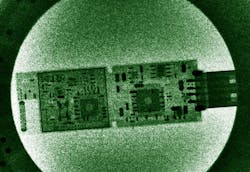Electron scattering of high-intensity laser photons sparks new behavior in light
By focusing laser light to a brightness 1 billion times greater than the surface of the sun (the brightest, or highest-intensity, light ever produced on Earth) physicists from the University of Nebraska-Lincoln have made the first measurements of high-order electron–photon scattering, or Thomson scattering. The measurements showed that more than 500 near-IR laser photons became on high-energy x-ray photon via Thomson scattering.1
The resulting x-ray pulses have the potential to generate extremely high-resolution imagery useful for medical, engineering, scientific, and security purposes. The team’s findings should also help inform future experiments involving high-intensity lasers.
Donald Umstadter and colleagues at the university's Extreme Light Laboratory fired their Diocles Laser at helium-suspended electrons to measure how the laser’s photons scattered from a single electron after striking it.
Under typical conditions, as when light from the sun strikes a surface, that scattering phenomenon makes vision possible. But an electron normally scatters just one photon of light at a time. And the average electron rarely enjoys even that privilege, Umstadter says, getting struck only once every four months or so.
Though previous laser-based experiments had scattered a few photons from the same electron, Umstadter's team managed to scatter nearly 1000 photons at a time. At the ultrahigh intensities produced by the laser, both the photons and electron behaved much differently than usual. Umstadter's team found that, above a certain threshold, the laser's brightness altered the angle, shape, and wavelength of the scattered light.
That phenomenon stemmed partly from a change in the electron, which abandoned its usual up-and-down motion in favor of a figure-eight pattern. As it would under normal conditions, the electron also ejected its own photon, but the researchers found that the ejected photon absorbed the collective energy of all the scattered photons, granting it the energy and wavelength of an x-ray.
The unique properties of that x-ray might be applied in multiple ways, Umstadter says. Its extreme but narrow range of energy, combined with its extraordinarily short duration, could help generate 3D images on the nanoscopic scale while reducing the dose necessary to produce them.
REFERENCE:
1. Wenchao Yan et al., Nature Photonics (2017); doi: 10.1038/nphoton.2017.100

John Wallace | Senior Technical Editor (1998-2022)
John Wallace was with Laser Focus World for nearly 25 years, retiring in late June 2022. He obtained a bachelor's degree in mechanical engineering and physics at Rutgers University and a master's in optical engineering at the University of Rochester. Before becoming an editor, John worked as an engineer at RCA, Exxon, Eastman Kodak, and GCA Corporation.
